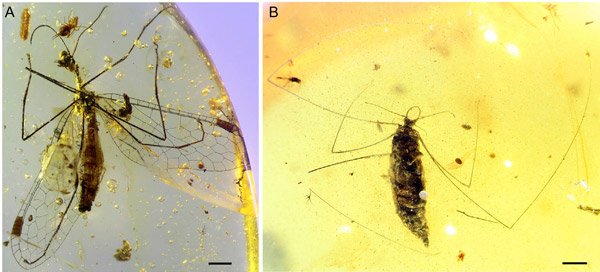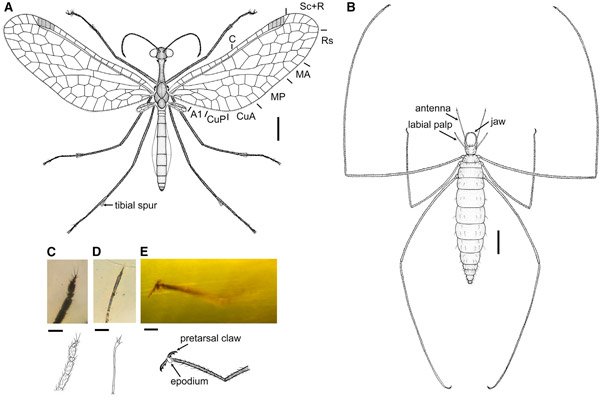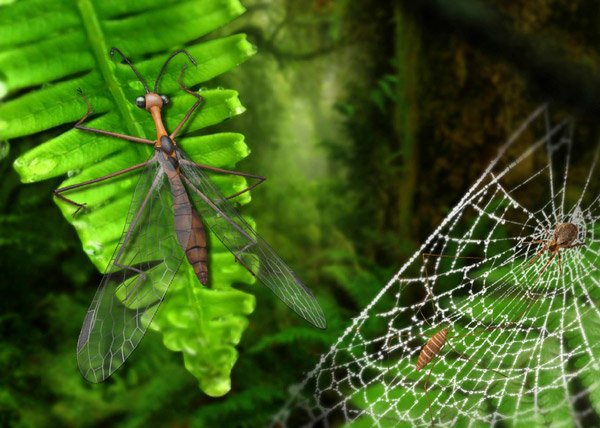The Burmese amber of the Cretaceous period found extinct killer spiders

Palaeoentomology found in Burmese amber aged about 99 million years, an unusual insect lacewing larva. Judging by the structure of the limbs, she hunted for spiders, walking around in their Trappers networks. In addition to the larvae in the same Burmese amber was found almost as unusual as the adult insect from the same squad that has lost the rear fenders. Scientists attributed the findings to both one and the same species, which was named Pedanoptera arachnophila.
Recently, Burma - amber of the Cretaceous period, which occurs from Myanmar (formerly Burma), in the state of South-East Asia - has become a constant source of scientific sensations. Leading universities and museums knowingly actively engaged in buying it. That in Burma will find well-preserved lizard, the pieces of the wings of birds extinct toothless Enantiornithes.
But most of all in Burmese amber insects - adults and larvae. The latter is especially valuable because terrestrial larvae, living away from bodies of water, almost not stored in normal sedimentary rocks, and amber are almost the only chance for them to learn something. And that chance recently introduced to scientists from China and the US, who was found in Burma bizarre larva (right in Fig. 1), relating to the order of insects lacewing (Neuroptera).
At first sight catches the eye long limbs larvae, with middle pair slightly shorter front and rear legs. But more importantly, that the claws that are arranged in pairs at the ends of its limbs, bear tiny teeth. Such a structure is not known among the claws lacewing larvae of other insects, but they have a long-legged bugs subfamily of-hischnetsy Emesinae, that prey on spiders.
Kinks in the claws help these bugs walk on the web and do not stick to it, picking up to her owner. Timing has claws and spiders themselves, building the trapping network. Therefore, the authors of the article believe that claws were found larvae of a similar application. Given that almost all lacewing larval stages are predators, the larva could roam the web with only one purpose - to eat the spider itself, or at least its prey.
In addition, the authors found in Burma adult lacewing insect from an extinct family Mesochrysopidae. It was called Pedanoptera arachnophila and is characterized by long legs, elongated pronotum and rear wings, reduced to the status of small plates with subtle veining. Such Diptera - is the hallmark of flies and wasps, whereas the order Neuroptera typical condition is the presence of two pairs of wings normally developed.

Examples almost complete reduction of the rear wings among lacewing insects can be counted on the fingers. One of them - a modern look Psectra diptera (Hemerobiidae), among normal chetyrehkrylyh representatives which for some unknown reason, there are individuals and Diptera. Another example Diptera - is an extinct family of Cretaceous Dipteromantispidae with prehensile front legs - it is, by the way, has recently been found in Burma (X. Liu et al, 2016. Halteriomantispa grimaldii gen et sp nov .: A new genus and species of... the family Dipteromantispidae (Insecta: Neuroptera) from the mid-Cretaceous amber of Myanmar). Finally, the rear fenders and reduced family nitekrylok (Nemopteridae), but still not to the point.
It turns out that P. arachnophila - this is actually the third known case of complete Diptera among Neuroptera. Given the unusual nature of this instance, the authors of the work attributed to this species and maggot-paukoubiytsu. "Communication between adults and larvae is confirmed by the presence in both stages a variety of unique anatomical specializations that are not known either among the living or among fossil Neuroptera», says the article.

I must say, the argument is not very convincing - there are plenty of examples where nothing remarkable nor adult insects possess quite amazing larvae and vice versa. Besides Diptera P. arachnophila are hardly the only unusual Neuroptera in Burma, because recently there have been found and other members of the squad with unique specializations, such as piercing-sucking mouthparts, presumably intended for bloodsucking (Vladimir N. Makarkin, 2016. enormously long, siphonate mouthparts of a new, oldest known spongillafly (Neuroptera, Sisyridae) from Burmese amber imply nectarivory or hematophagy). And who knows what will bring us new finds.
Generally, in the case of insects with complete metamorphosis correlation larvae and adults (adults) - this is a very difficult task. Even for many of today's species is not known exactly what they correspond to larvae - what to say about the fossil material. Therefore, the conclusion that the long-legged larva paukoubiytsa was precisely P. arachnophila, it seems highly hypothetical, even if we consider that they had similar proportions of the legs and the size (body length of larvae - 3-5 mm body length of adults - 7 mm) . Most likely, the species found larvae belonging will never be established with certainty.
However, one thing is certain - in the middle of the Cretaceous period there were such highly specialized forms, as this hunter spiders among insect larvae. Interestingly, these professionals then disappeared without a trace - in any case, these days lacewing can not boast of anything similar. The only family of Neuroptera, which is linked his fate with spiders - it mantispidae (Mantispidae), but their larvae live in the spider cocoons and never travel across the web.